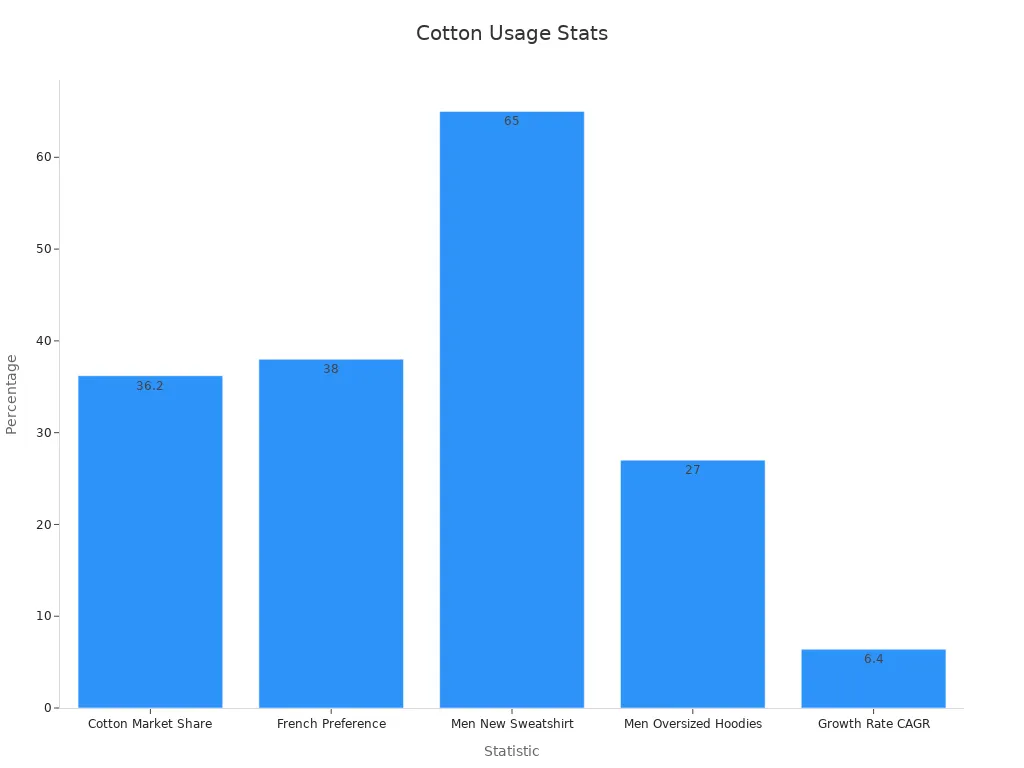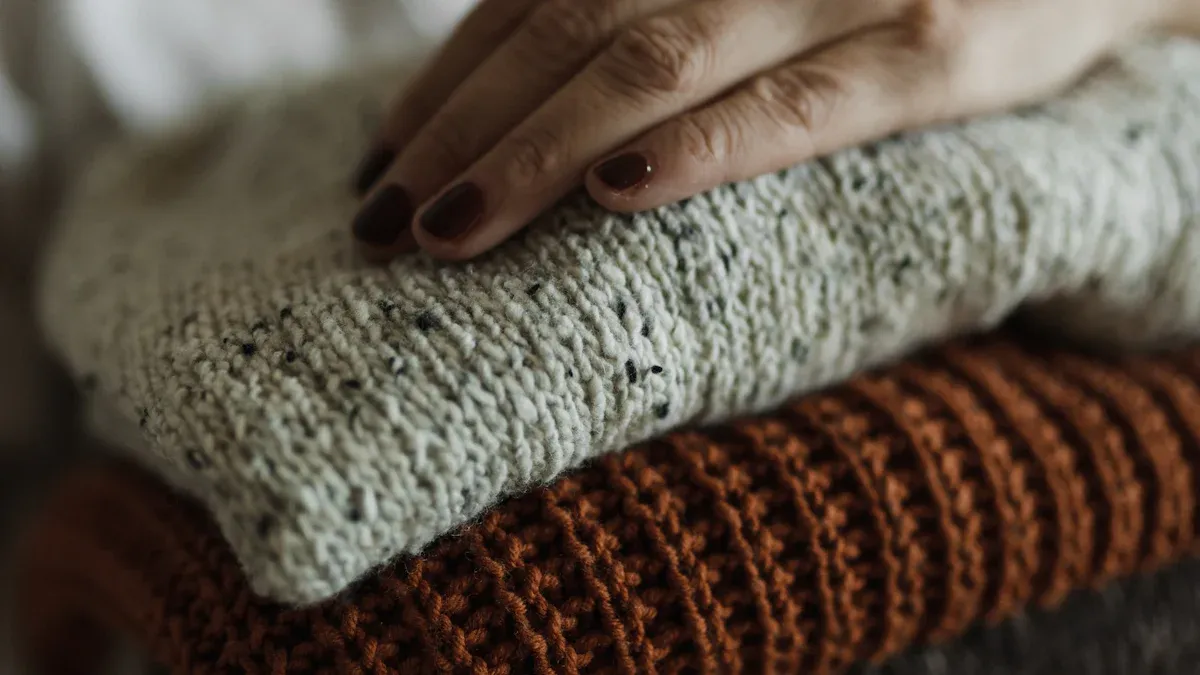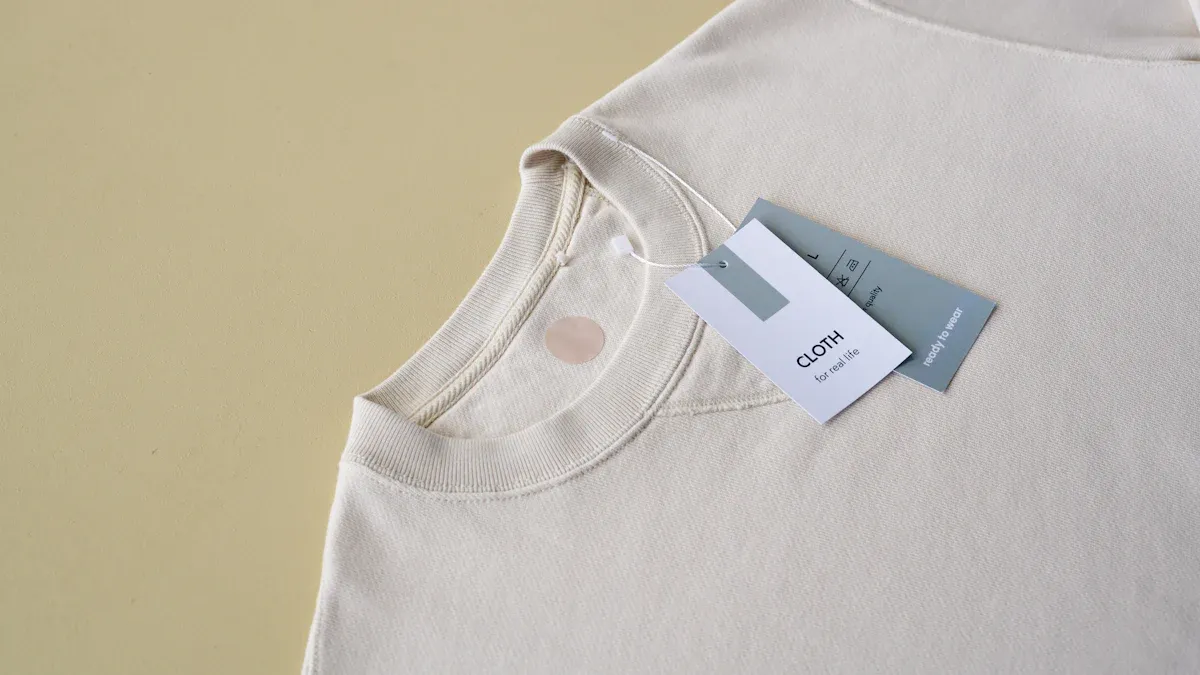
Cotton Fabric For Sweatshirts stands out in the apparel industry for its comfort, breathability, and skin-friendliness. Over 84% of consumers rate cotton clothing as the most comfortable and softest option. The chart below highlights the strong popularity and usage rates of cotton in sweatshirts worldwide.

Key Takeaways
- Cotton sweatshirts offer unmatched comfort, breathability, and skin-friendliness, making them ideal for everyday wear and sensitive skin.
- Proper care, like washing in cold water and air drying flat, helps prevent shrinkage, stretching, and maintains the sweatshirt’s shape and softness.
- While cotton excels in comfort and moisture absorption, it dries slowly and wrinkles easily, so it requires more maintenance compared to synthetic fabrics.
Cotton Fabric For Sweatshirts: Main Advantages

Comfort and Softness
Cotton Fabric For Sweatshirts delivers a superior level of comfort that appeals to a wide range of consumers. The natural fibers create a soft texture that feels gentle against the skin. Many people choose cotton sweatshirts for daily wear because the fabric adapts well to body movements and does not cause irritation. The plush feel remains consistent even after multiple washes, making cotton a reliable choice for those who prioritize comfort.
Breathability and Airflow
Breathability stands as a hallmark of Cotton Fabric For Sweatshirts. The structure of cotton fibers allows air to circulate freely, which helps regulate body temperature. This airflow prevents overheating during physical activity or in warmer environments. Sweatshirts made from cotton keep wearers cool and comfortable, especially during transitional weather.
Skin-Friendliness and Hypoallergenic Qualities
Cotton Fabric For Sweatshirts is often recommended for individuals with sensitive skin or allergies. Dermatological studies confirm its suitability for people with atopic dermatitis and other skin conditions.
| Aspect | Details |
|---|---|
| Background | Atopic dermatitis patients have sensitive skin; lyocell and cotton compared for suitability. |
| Objective | Compare fabric preferences and effects on itching between 100% lyocell and 100% cotton. |
| Methods | 30 subjects with/without AD wore cotton or lyocell clothing for 1 week each, with washout. |
| Results | Lyocell preferred for softness and moisture control; cotton equivalent to lyocell in itch reduction; no significant difference in itching or skin barrier (TEWL). |
| Conclusion | Cotton is equivalent to lyocell in reducing itch and suitable for sensitive skin patients. |
- Experts recommend 100% cotton for eczema and sensitive skin due to its cool, breathable, and non-irritating nature.
- Hypoallergenic clothing made from 100% cotton is available and certified by the Global Organic Textile Standard (GOTS), ensuring chemical-free and skin-friendly textiles.
- Brands like Cottonique and Cottonmill offer GOTS-certified hypoallergenic cotton clothing, supporting cotton’s suitability for sensitive skin.
These findings highlight why cotton remains a top choice for those seeking gentle, hypoallergenic apparel.
Easy Decoration and Personalization
Cotton Fabric For Sweatshirts offers excellent versatility for decoration and personalization. Cotton-rich fabrics respond exceptionally well to embossing, producing crisp, well-defined raised patterns that hold their shape due to the natural fibers’ ability to compress and retain form under heat and pressure. Premium sweatshirts often use a 100% cotton face or cotton blends to balance comfort and embossing quality. Customer feedback highlights the durability of embossed designs, with one noting the embossed logo remained perfect after 15 washes. This demonstrates that cotton sweatshirt fabric is highly suitable for tactile, durable, and visually distinctive decoration methods like embossing, which also maintain quality over time.
The TE Vizja x MerchUp case study further illustrates how cotton sweatshirt fabric (90% cotton, 10% polyester) is easily decorated and personalized through a collaborative design process. The fabric was individually dyed to match specific Pantone colors chosen by the customer, demonstrating color customization. Unique double embroidery with fabric filling was applied, showcasing the fabric’s suitability for detailed and durable embroidery. Additionally, personalized tags were added to each sweatshirt, enhancing the uniqueness of each piece. This project resulted in 300 personalized sweatshirts that combined comfort, aesthetic appeal, and a strong sense of identity for the school, proving the fabric’s adaptability for various decoration techniques.
Heat Resistance and Warmth
Cotton Fabric For Sweatshirts provides reliable warmth in cooler climates. Scientific data indicates that cotton, as a plant-derived fiber, provides heat retention and warmth primarily through its high moisture absorption and breathability. These properties contribute to insulation by managing moisture and allowing air circulation within the fabric. Although cotton’s insulation is somewhat less effective compared to animal fibers like wool, it still retains body heat by trapping air within its structure, influenced by fabric thickness and porosity. Cotton is also used in blends, such as polyester-cotton, to enhance insulation and durability. This technical understanding supports the claim that cotton can provide warmth in cooler climates, albeit with slightly lower thermal resistance than some other natural fibers.
Moisture Management
Cotton Fabric For Sweatshirts excels in moisture management, making it a practical choice for active lifestyles.
- Moisture management in textiles is characterized by parameters such as water vapor transmission rate, water vapor permeability, absorption rate, wicking time, wetted area/radius, drying time, one-way transfer index, overall moisture management capability (OMMC) index, and evaporative resistance.
- Sweating thermal manikins use a fabric ‘skin’ that must have good moisture wickability and quick spreading properties to simulate sweat absorption and evaporation accurately.
- The fabric ‘skin’ is recommended to be engineered from a blend of hygroscopic/hydrophilic fibers like cotton combined with spandex to optimize moisture wickability.
- Fabric thickness affects moisture management: a medium thickness (e.g., around 0.50 mm) is ideal to maintain surface saturation without drying out too quickly or lowering surface temperature excessively.
- These testing methods and fabric engineering principles provide academic and practical insights into how cotton’s wickability in sweatshirts can be evaluated and optimized.
Cotton’s ability to absorb and release moisture helps keep the wearer dry and comfortable, especially during physical activity or fluctuating temperatures.
Cotton Fabric For Sweatshirts: Main Disadvantages
Shrinkage After Washing
Shrinkage remains one of the most common concerns with Cotton Fabric For Sweatshirts. Cotton fibers absorb water and swell during washing, which causes the fabric to contract as it dries. High temperatures in both washing and drying cycles can intensify this effect. Over time, repeated laundering may lead to noticeable size reduction, especially if the garment is not pre-shrunk or treated with special finishes. Many consumers find that their sweatshirts fit more snugly or lose their original shape after several washes. Proper care, such as washing in cold water and air drying, can help minimize shrinkage, but the risk never fully disappears.
Wrinkling and Creasing
Cotton Fabric For Sweatshirts tends to wrinkle and crease easily, which can affect the garment’s appearance and require extra maintenance. Statistical studies have shown that factors like spinning speed and wash load during laundering significantly influence the smoothness of cotton fabrics. Increased wash load leads to more severe wrinkling due to changes in fabric motion dynamics. Functional finishes, such as wrinkle-free or stain-release treatments, can improve crease recovery but may also reduce fabric strength and increase pilling. Some eco-friendly alternatives, like chitosan citrate, offer effective wrinkle resistance without the health hazards associated with formaldehyde-based finishes. However, even with advanced treatments, cotton generally requires ironing or steaming to maintain a crisp look.
Slower Drying Time
Cotton Fabric For Sweatshirts dries more slowly than synthetic alternatives. This slower drying time results from the fabric’s high moisture absorption and heavier weight. Cotton fibers can absorb up to 24-27 times their own weight in water, causing garments to feel damp and heavy for extended periods. The fabric’s construction, including thickness and density, further influences drying speed. Synthetic fabrics, such as polyester, dry much faster due to their hydrophobic nature and superior moisture-wicking properties.
- Cotton absorbs and retains more moisture, leading to longer drying times.
- The limited breathability of cotton slows evaporation, keeping garments damp.
- Synthetics dry quickly and wick moisture away from the skin.
| Parameter | Cotton | Polyester |
|---|---|---|
| Moisture Absorption | High (24-27x weight) | Low (hydrophobic fibers) |
| Moisture Retention | High | Low |
| Drying Time | Slow | Quick |
| Moisture-Wicking Ability | Low | High |
Potential for Deformation and Stretching
Cotton Fabric For Sweatshirts can lose its original shape over time, especially with frequent wear and improper care. Cotton fibers absorb water and become more pliable, making them susceptible to stretching and deformation. Hanging wet cotton garments can cause areas like the shoulders and neckline to stretch out due to the weight of the water. Research on sportswear fabrics shows that cotton blends can stretch up to 87% under stress, with minimal contraction afterward. The inclusion of fibers like spandex or polyester can improve shape retention, but pure cotton remains less resilient than synthetics. Durable press finishes and cross-linking treatments can enhance deformation resistance, yet repeated washing and wearing still pose risks for shape loss.
Tip: To reduce stretching, lay sweatshirts flat to dry and avoid hanging them when wet.
Moisture Retention and Loss of Insulation When Wet
Cotton’s hydrophilic nature means it absorbs and retains significant amounts of moisture. The cellulose molecules in cotton fibers bond with water, leading to high moisture retention. Fabric structure, such as porosity and yarn thickness, also affects how much moisture the fabric holds. Thicker yarns absorb more water but spread it less efficiently, causing the garment to feel heavier and wetter for longer periods. While cotton excels at absorbing sweat, it loses much of its insulating ability when saturated. Wet cotton sweatshirts can feel cold and uncomfortable, making them less suitable for damp or rainy conditions.
- Cotton absorbs moisture in micropores between fibers and yarns.
- High moisture retention leads to a loss of warmth and comfort when wet.
Durability Compared to Synthetics
Cotton Fabric For Sweatshirts offers moderate durability but generally falls short of synthetic fabrics in terms of lifespan and resistance to wear. Synthetic materials, such as polyester, retain their shape, resist wrinkles, and withstand abrasion better than cotton. High-quality cotton can last for years with proper care, but it remains prone to fading, wrinkling, and gradual wear. Blending cotton with synthetics improves strength and longevity, providing a balanced option for those seeking both comfort and durability.
| Aspect | Cotton | Synthetic Fabrics |
|---|---|---|
| Durability | Moderate; prone to wear and wrinkles | High; retains shape and resists wear |
| Lifespan | Several years with care | Longer due to resistance |
| Maintenance | Needs ironing and careful washing | Easier to maintain |
| Usage Suitability | Best for casual, dry environments | Ideal for active, outdoor use |
Innovations like mercerization, pre-shrinking, and nanotechnology treatments can enhance cotton’s resilience, but synthetics still outperform cotton in demanding conditions. For everyday comfort, cotton remains a popular choice, but those seeking maximum durability may prefer synthetic or blended fabrics.
Care and Maintenance for Cotton Sweatshirt Fabric
Washing and Drying Best Practices
Proper washing and drying routines help preserve the quality of cotton sweatshirt fabric. Textile experts recommend the following steps for optimal care:
- Turn sweatshirts inside out before washing to reduce surface abrasion.
- Use cold water and mild detergents designed for delicate textiles.
- Avoid fabric softeners; opt for natural alternatives like white vinegar to maintain softness.
- Place sweatshirts in garment nets and close zippers to prevent damage.
- Air dry sweatshirts in the shade to protect color and softness. Tumble drying can cause shrinkage and loss of softness.
- Treat stains promptly with white vinegar and cold water for best results.
Tip: Wash sweatshirts after every 5-6 wears to extend their lifespan and maintain appearance.
Minimizing Shrinkage and Deformation
Shrinkage and deformation remain common concerns for cotton garments. Industry standards, such as ASTM D3774, set acceptable shrinkage rates between 2-5%. To minimize these issues, follow these guidelines:
- Wash sweatshirts in cold water using gentle cycles.
- Avoid high heat during both washing and drying.
- Air dry or lay garments flat to dry, rather than hanging them when wet.
- Always read and follow care labels for fabric-specific instructions.
- Choose pre-shrunk or mercerized cotton when possible for added stability.
Preventing Pilling and Maintaining Appearance
Maintaining a sweatshirt’s appearance requires attention to pilling prevention. Textile research suggests these best practices:
- Turn sweatshirts inside out before washing to limit friction.
- Select gentle wash cycles and avoid overloading the machine.
- Use liquid detergents for delicate fabrics and avoid bleach.
- Air dry garments flat or use low heat if necessary.
- Store sweatshirts folded in cool, dry places away from sunlight.
- Remove pills with a fabric shaver or fine-toothed comb if needed.
Note: High-quality cotton with longer fibers resists pilling and keeps sweatshirts looking new longer.
Cotton Fabric For Sweatshirts vs. Other Materials

Cotton vs. Polyester Sweatshirts
Cotton and polyester sweatshirts serve different needs. Cotton Fabric For Sweatshirts offers natural softness and breathability, making it comfortable for daily wear. Polyester, on the other hand, excels in durability and moisture resistance. Polyester sweatshirts resist shrinking, wrinkling, and fading, and they dry quickly. Cotton requires more careful washing and tends to shrink or wrinkle over time. The table below summarizes key differences:
| Aspect | Cotton | Polyester |
|---|---|---|
| Comfort | Soft, breathable | Less breathable, moisture-wicking |
| Durability | Prone to shrinking, wrinkling, fading | Resistant to shrinking, wrinkling, fading |
| Moisture Management | Absorbent, holds moisture longer | Moisture-resistant, quick drying |
| Maintenance | Careful washing needed | Easy care, wrinkle-free |
| Cost | Generally more expensive | Cheaper due to mass production |
Polyester sweatshirts are ideal for activewear and outdoor use, while cotton suits casual, everyday wear.
Cotton vs. Cotton-Polyester Blends
Blending cotton with polyester combines the strengths of both fibers. These blends improve durability, wrinkle and shrink resistance, and moisture management. Common ratios like 80/20 or 50/50 affect softness and performance. For example, a 50/50 blend balances cotton’s comfort with polyester’s quick drying and strength. Blends also reduce production costs and offer better elasticity. Many consumers choose blends for sweatshirts that need to withstand frequent washing and active use.
Cotton vs. Fleece and Other Alternatives
Fleece sweatshirts, usually made from polyester, provide immediate warmth and softness. Fleece dries quickly and wicks moisture efficiently, making it suitable for cold or wet conditions. However, fleece can trap heat and moisture, which may reduce comfort during long wear. Cotton absorbs more moisture and dries slower, but it offers better breathability and long-term comfort. French terry, another alternative, sits between cotton and fleece in moisture management and durability. Fleece excels in drying speed, while cotton remains a favorite for those who value breathability and a natural feel.
Suitability for Different Uses and Lifestyles
Cotton Fabric For Sweatshirts works best for casual wear, sensitive skin, and warm climates. Polyester and blends suit active lifestyles, sports, and outdoor activities due to their durability and moisture-wicking properties. Fleece is ideal for cold weather and layering. Consumers seeking easy care and longevity often prefer blends or polyester. Those who prioritize comfort, breathability, and hypoallergenic qualities choose cotton. Each material offers unique benefits, so selecting the right fabric depends on personal needs and daily routines.
Cotton Fabric For Sweatshirts delivers comfort and breathability while remaining gentle on skin. Many experts highlight its environmental benefits. Surveys show most consumers value natural fibers, and scientific studies confirm cotton biodegrades quickly. People seeking sustainability and comfort should consider this fabric for their sweatshirts.
FAQ
How can someone prevent cotton sweatshirts from shrinking?
Wash in cold water. Air dry flat. Avoid high heat in dryers. Choose pre-shrunk cotton when possible. Always follow the care label for best results.
Are cotton sweatshirts suitable for people with sensitive skin?
Dermatologists recommend 100% cotton for sensitive skin. The fabric feels soft, contains no harsh chemicals, and rarely causes irritation or allergic reactions.
Do cotton sweatshirts lose their shape over time?
- Cotton sweatshirts may stretch or deform with frequent wear.
- Laying garments flat to dry and avoiding heavy loads in the washer helps maintain shape.
Post time: Jun-16-2025